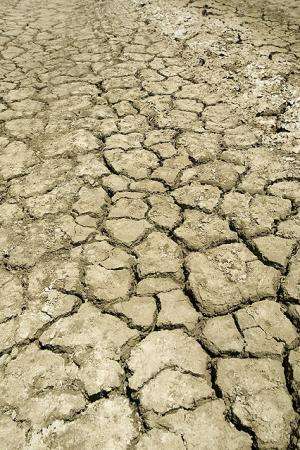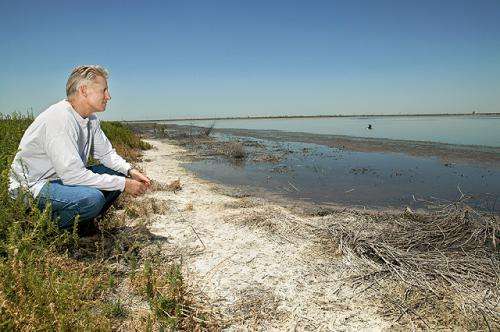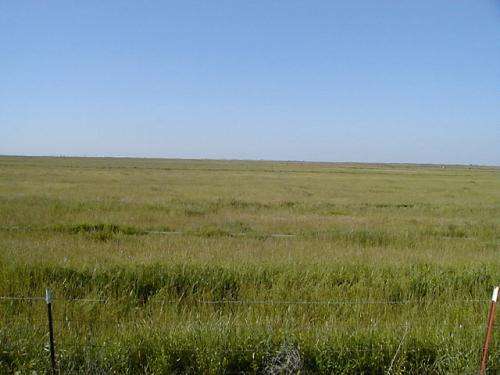Irrigation wastewater can help salvage damaged soils

Agricultural producers on the west side of California's San Joaquin Valley (WSJV) used to drain irrigation wastewater into Kesterson Reservoir, a series of holding ponds that were part of the San Luis National Wildlife Refuge. But selenium levels in the water became hazardous to waterfowl, so the storage facility was closed in 1987. Since then, farmers have been keeping the wastewater—which also contains salt and traces of arsenic, boron, and molybdenum—in evaporation ponds on their own land, which takes around 10 percent of the crop land out of production.
Agricultural Research Service soil scientist Dennis Corwin and his colleagues had another idea. They thought it might be possible to use the spent wastewater for irrigating salt-tolerant forage grown on marginally productive saline and sodic soils. Sodic soils contain large quantities of sodium, which is one of the minerals found in salt compounds. Saline soils are contaminated with salt compounds at levels that significantly limit plant growth.
If this approach worked, farmers would have a viable alternative to simply storing the spent wastewater until it evaporated, and they would be able to reclaim degraded soils and produce livestock forage in the bargain. Irrigating with wastewater could also help stretch water supplies in a region already struggling with limitations imposed by intermittent droughts.
Corwin and his partners conducted their investigation on a private 80-acre field in the WSJV. To the scientists, it was a worst-case example of the type of damage they hoped to reverse—the crusted saline-sodic soils at the site drained so poorly that irrigation was a waste of time and money.
"One end of the field had so much salt on the surface that it looked like it was covered in snow," says Corwin, who works at the ARS Water Reuse and Remediation Research Unit, part of the U.S. Salinity Laboratory in Riverside, California.

The first step was to install tile drains for channeling subsurface leachate off the field, which would be an essential part of the reclamation process. Then, geophysical mapping techniques developed at the U.S. Salinity Laboratory were used to generate a three-dimensional map of salinity and trace elements. After using this map to identify soil-sampling sites, the team collected samples at 1-foot depth increments five times—1999, 2002, 2004, 2009, and 2012—over the 12-year study period.
During the first 2 years of the study, a stand of salt-tolerant Bermuda grass was established at the site and irrigated with the spent wastewater. "We had cattle grazing at the site within 2 years of starting up," Corwin says. "The farmer was so pleased with the results that he used the same approach on other marginally productive fields that had damaging saline-sodic levels."
In-depth findings
The striking results weren't just on the surface. The researchers determined that the irrigation wastewater was leaching salts and trace elements below the root zone, which resulted in a significant and rapid improvement in soil quality. They observed an overall decrease in levels of salts, boron, and molybdenum through the root zone. They also noted an overall decrease in the soil's sodium absorption ratio (SAR), which is determined by comparing levels of sodium, magnesium, and calcium.
From 1999 to 2004, salinity decreased 21 percent, SAR decreased 19 percent, boron decreased 32 percent, and molybdenum decreased 67 percent in the top 4 feet of the soil profile. After 2004, each continued to decrease and gradually leveled off by 2009.

Backsliding
In the final 2 years of the study, drought had reduced water supplies so completely that all sources of drainage water had been used. Even backup degraded water, such as municipal wastewater, was no longer available for irrigation. As a result, irrigation stopped at the site, and rain became the only source of water that the field received.
During this time, salts, SAR, soil acidity, and levels of boron, molybdenum, and selenium increased throughout the soil profile. Salinity and SAR almost reached their 1999 levels, while soil acidity and selenium levels exceeded them. In just under 2 years after irrigation stopped, the soil had nearly returned to its original poor quality.
"I thought reclaimed soils in the WSJV might revert in 5 years, so I was amazed at how quickly it happened," Corwin says. "The shallow water table was unquestionably the reason for the quick reversion. Maybe some disking for weed control would have slowed the reversion, because when the weeds drew water up from the lower portion of the soil profile, they helped to bring back boron, salt, and molybdenum that had been leached just below the alfalfa's root zone."
At the end of the study, Corwin and his colleagues concluded that recycling drainage water for salt-tolerant forage crops could potentially free up as much as 84,000 acres of land currently used for evaporation ponds. The approach not only reduced drainage volumes, but also reclaimed marginally productive soil and used an alternative water source, which reduced demand on limited quantities of good quality water. However, Corwin noted that soils irrigated with drainage water would need periodic monitoring, particularly if they are left fallow for any length of time, to make sure that salts and trace elements did not begin to reaccumulate to potentially problematic levels.
"The first part of the study showed how quickly soils above a water table 5 to 6 feet deep can be brought back to productivity," he says. "The long-term study showed how the soil response levels off as irrigation continues—and how quickly soil can revert to its former condition once irrigation stops."
Corwin published his results in 2012 in the Journal of Environmental Monitoring.
"Irrigation Wastewater: Waste Not, Want Not" was published in the April 2013 issue of Agricultural Research magazine.
More information: Soil scientist Dennis Corwin on the salt-encrusted edge of an evaporation pond that received drainage water from nearby tile-drained, irrigated land.
Journal information: Agricultural Research
Provided by Agricultural Research Service















